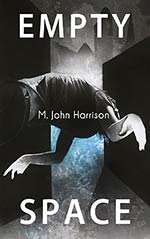
![]() thrak
thrak
6/21/2014
![]()
"The thing about life is that if you get it wrong you can't go back."
"The things she missed about this town were gone. They had never been here anyway. They had vanished not into the current disaster, but years ago, into her own. The past wasn't real but it was all she had: that's how you feel when your life has faltered."
"Never do anything unless you're lost of on fire, Doctor. Otherwise how will you remember it?"
In the third and final book in the Kefahuchi Tract sequence, M. John Harrison doesn't tie up loose ends so much as explore how in real life we rarely get the neat closure supplied in narratives. 'Empty Space' lives up to its title, not in terms of content, but thematically; the space between people, within their understandings and perceptions of themselves and others, and the spaces between the stars, becomes a central motif of the trilogy. In 'Empty Space' we learn that Anna did not pass on Michael Kearney's hard drive with the new system of physics on it to Brian Tate at the end of 'Light', uncoupling the parts of these books set in the past from the parts set in the future. This rift is left unresolved. We also learn that the fate of Fat Antoyne, Liv Hula and Irene the Mona has been less than plain sailing since their decision to move on with their lives at the end of'Nova Swing', and that following the disappearance of Lens Aschemann, the assistant has been able to fill his shoes amply in Site Crime but still has no idea who she really is, still has not chosen a name for herself. The building tensions alluded to at the end of 'Nova Swing' are inexorably heading for interstellar war, and the tipping point is the discovery of the Aleph, an alien artifact and possibly devastating ancient weapon which manifests as a woman falling into eternity.
Structurally 'Empty Space' echoes 'Light', with one strand set in the near future following Anna Waterman, Michael Kearney's widow, who since his disappearance remarried and had a child but never quite moved on, and two set in the future following the crew of the Nova Swing as they attempt to smuggle goods from the Site under the guidance of a returned Ed Chianese, and the assistant as she attempts to track them down and stop them whilst searching for her own identity, while galactic war breaks out. Like 'Nova Swing', while Harrison once again takes great delight in deconstructing standard space opera tropes, 'Empty Space' is essentially about the human characters. Whereas the previous book was all about the importance of moving on from your past, 'Empty Space' is about how difficult that really is, the one mistake in our past that we are forever afterwards untangling and trying to make sense of.
The main SF trope Harrison plays with this time round is the old classic, the space battle. There are several fantastic sequences of spaceships fighting, so intense, action packed and explosion filled as to verge on the parodic. One of them climaxes with a spaceship blowing up an entire planet by flying through the planet core. Clearly Harrison learnt from the late, great Iain M. Banks that there is absolutely no point in having a Big Dumb Object unless you are going to explode it spectacularly further down the line. Yet Harrison deflates these scenes by reminding us that this is a war, and people are dying. Unlike other space operas, we get to see the cost of exciting interstellar battles in terms of billions of displaced refugees frightened for their lives, friends, relatives and loved ones lost, families split up with no way of ever finding each other again. Harrison also subverts the standard trope of human superiority. The boys from Earth were spoiling for a fight and arrogantly convinced that the ancient artifact would be a deadly weapon that would put them in a position of military power; when it turns out not to be the case they are given a sound thrashing by superior alien forces.
Beyond the pyrotechnics, 'Empty Space' focuses in on what makes its characters tick. Anna and the assistant's ultimate fate together as the falling woman makes narrative sense. Both of them are self-absorbed and fixated on a past that they cannot get back. Anna's selfishness, her fixation on her own needs while her daughter is undergoing a serious health scare, is reflected in the assistant's constant search for her own identity at the expense of everything else. Both of them, once uncoupled from time and able to look at themselves objectively whilst trying to warn them about their futures, become frustrated with their own tunnel vision. Meanwhile, Fat Antoyne, Liv Hula and Irene the Mona have to deal with the decisions way back in their pasts that lead them to become the people they are now. Ultimately, despite a life of running from it, each of them has to face their past. In many ways, the main thread running through the whole series has been our relationship to our past, and how the way we deal with it determines our future. The characters in the Kefahuchi Tract series who fall are all doomed, not by outside circumstances, but by their own inability to face their pasts and move on from them.
http://goldenapplesofthewest.blogspot.co.uk/2014/06/m-john-harrison-kefahuchi-tract-book.html